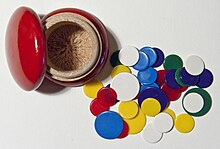Flea game
Flea , flea game or flea hop is a game of skill or children's game for two to six people. The name comes from the fact that small round plastic or wood chips are flicked through the air and are reminiscent of jumping fleas . The children's game was originally developed in England at the end of the 19th century as Tiddledy Winks, and was launched in 1887 by Parker Brothers.
The modern version was created in 1955 at Cambridge University: In England and North America (USA) tournaments are organized for individuals and teams made up of several pairs.
The game
General
In the German-speaking world, the version with a red lacquered, turned wooden box has been widespread since around 1960.
The color and roundness of the lid are reminiscent of the game pieces, its curved top and its side protrusion (about 8 cm in diameter) are reminiscent of a mushroom.
The 42 game pieces are flat, circular discs made of nylon with a semicircular edge in six different colors (white, yellow, red, green, light and dark blue) for up to as many players. The thickness (height) of the chips is just under 2 mm. Each set of one color consists of 6 small ones, about 15 mm in diameter, the jumping fleas, and one larger (about 25 mm) that is clamped between the thumb and forefinger. With it as a tool - held more flat than 45 ° - the flea is pressed quite firmly close to the edge. By sliding towards the edge of the flea and sliding down there, the flea escapes this clamping, is accelerated horizontally on the round of the edge and vertically upwards due to the springing back of the pressed base. The result is a small parabolic trajectory on which the flea also does somersaults.
If there are fewer than 6 players, chips that are not used can be placed in the lid; the bottom part of the can serves as a target pot.
Game flow
Each player receives six small and one large chips of one color. In turn, the attempt is now made to snap each of the small chips one by one into the wooden body. To do this, press the large chip onto the edge of the small one. The winner is whoever was the first to flick all of his chips into the mushroom.
In order for the snipping to work well, you need a flat, hard surface with a somewhat springy surface, i.e. a table with a tablecloth or a floor with a carpet. The initial removal of a chip is freely chosen. If the chip hits next to the mushroom, it stays there and has to be flicked from there in a later round. If you succeed in snapping a token into the mushroom, it is the turn of that player again. If a chip falls outside the playing field (on the floor, next to a playing surface, etc.), it is put back in its old place. If a token lands on another player's, it can only be played again when the opponent's chip has been removed. The game ends when a player has flicked all of his small chips into the mushroom.
Related games
In 1993, the Schmidt Spiele company brought out a flea game in which two to four players each snap ten small chips into zones with different points in a box. The winner is whoever has collected the most points.
Mechanical analogy
Plucking a guitar string with a pick with a rather pointed contour is geometrically and mechanically similar thanks to the rounding diameter of around 1 mm. The string is deflected in a pressing manner, hooks with it, sticks or rubs slidingly on the (vulgo :) "Blattl", escapes the forces and then swings freely.
Web links
- Flea game in the Luding game database
- GDR flea game


